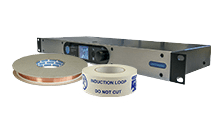For a complete hearing loop system overview see below:
A functional hearing loop system that provides a genuine benefit to its users and fulfils all the requirements of the international performance standard consists of 5 main components.
Ampetronic manufacture and supply a complete range of products to satisfy the requirement of these 5 components which are listed below with explanatory notes, if you can’t find what you're looking for or require a bespoke solution please contact us:
1. An audio source (such as a microphone)
An induction loop system will only produce a quality and intelligible audio signal if the source sound is captured correctly. The sound may be a voice, in which case a microphone is required, or an audio signal such as a TV or mixing desk which can be captured using a line connection.
Ampetronic supply microphones for counter and small area loop systems, for larger installations our amplifiers are designed to work with a wide range of professional audio equipment.
2. An Induction Loop Driver (amplifier)
An induction loop / hearing loop amplifier is usually referred to as a ‘driver’ and is at the heart of an Induction Loop system, they should not be confused with a voltage drive speaker amplifier as they are specifically designed to drive current into the loop cable. Ampetronic provide the largest selection of specialised induction loop driver solutions on the market, each designed to suit a specific application.
| Rooms | Metal loss control | Low spill |
| Counters | Intercoms | Vehicles |
| Wall mounted | Lifts (elevators) | Domestic (TV etc.) |
3. The copper ‘loop’ cable and fitting accessories
The most obvious component of an Induction Loop system is the cable that is used to form the actual ‘loop’ or ‘loops’. Ampetronic induction loop cable is available as direct burial cable, or as a flat copper tape for installation under carpets or other floor coverings. It is always advisable to use Ampetronic’s Warning Tape with flat copper tape which not only adheres it to the floor, but also warns carpet fitters about the loop so they don’t accidentally cut it.
4. Signage and notification
An essential part of any induction loop system is adequate signage. Unless a potential user already has their hearing aid set to the telecoil setting, which is highly unlikely, then a loop system is both invisible and inaudible. Nobody will use it if they don’t know it’s there. Signage should be placed at all entry points and on room walls. Ampetronic induction loop amplifiers come with a sign in the box.
5. Receiver & testing equipment
All induction loop systems should be supplied with equipment to allow the operator to regularly listen to the loop to ensure that it is switched on and to check that it operating as intended. Loop receivers can also be handed out to hearing impaired users who do not have telecoil enabled hearing aids.
If you have any questions or would like any more information about hearing loop system overview please contact us on +44 (0) 1636 610062 or email sales@ampetronic.com


